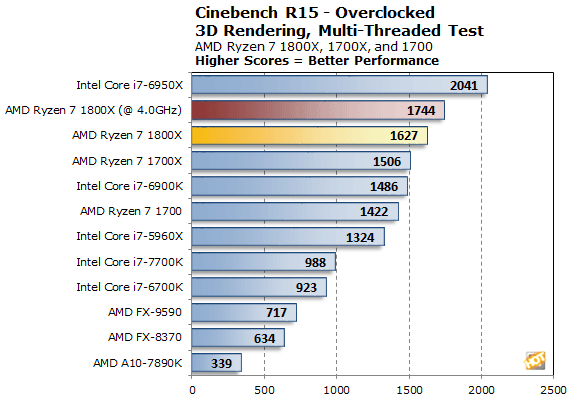Overclocking AMD's Ryzen 7 Processor And Power Consumption
We also spent some time overclocking our AMD Ryzen 7 1800X processor in Gigabyte's Aorus AX370-Gaming 5 motherboard to see how much additional frequency headroom the chip had left under its hood. Before we dive into the results, however, there are a number things we need to point out.
Overclocking seems like a work-in-progress at this point in time with Ryzen and the AX370 chipset. There are handful of overclocking-related features enthusiasts have grown accustomed to in recent years that are simply not available just yet, and it's unclear whether they'll be coming to the platform in the near term. For example, there are no per-core turbo / multiplier settings available. If you want to overclock Ryzen, simple multiplier adjustments affect all CPU cores, across the board. There are also no memory / BCLK straps. You can change the memory multiplier, but fine tuning via BCLK adjustments will also alter your PCI Express clock, etc. Manually setting CPU multipliers also automatically disables features like turbo boost and XFR. The processors essentially work in two modes -- Default mode enables all of the power and clock gating features, while Overclocked mode allows the CPU to ride along at the specified settings.
The kind of overclocked speeds we're seeing with early Ryzen processors may also seem quizzical. Take the Ryzen 7 1800X, for example. This processor is advertised as having a 3.6GHz base clock, with a 3.7GHz all-core turbo boost clock, and up to a 4.0 - 4.1GHz single-core boost clock with XFR. Since straight overclocking requires altering speeds on all-cores, however, overclocks without exotic cooling solutions will likely hover in the 3.9-4.1GHz range without using up the processor's thermal budget. With liquid-nitrogen, AMD was able to break a record at its tech day event, but the CPU they used only hit 5.2GHz.
AMD is doing some things to make overclocking super easy though. Its Ryzen Master software looks very much like the Wattman tool available with Radeon GPUs. A single application lets you alter multiplers and voltages from within Windows, monitor temperatures and clocks, and save settings to different profiles. The software even gives users the ability to disable cores if they'd like to push a fewer number of cores as high as possible, but that feature requires a system reboot. Although there are individual sliders per core, they all work in tandem at this time -- as we said, there are no per-core overclocking features available at this time.


To overclock our Ryzen 7 1800X we experimented both with Ryzen Master and the BIOS on the Gigabyte Aorus AX370-Gaming 5 motherboard and topped out at an all-core overclock of 4.0GHz, with 1.35 volts supplied to the CPU. For cooling, we stuck with the tower-type Thermaltake Contact Silent 12 we showed you on a previous page. At these settings, the CPU topped out at just shy of 90'C and was perfectly stable. Bumping things up to 4.1GHz would result in frequent crashes and the system wouldn't boot properly at 4.2GHz. With more voltage and more powerful cooling, however, somewhat higher clocks would likely be possible, but don't expect to hit the same kind of frequencies Intel's 14nm processors are capable of, with this generation of Ryzen at least.
While overclocked we re-ran a couple of tests with mixed results. Cinbench showed a nice gain and pushed the 1800X closer to the top of the charts. The Crysis CPU benchmark showed a small gain, but not enough to overcome the issues we discussed earlier with the benchmark.
|
Before wrapping things up, we'd also like to talk a bit about power consumption. Throughout all of our benchmarking and testing, we monitored how much power our Ryzen-based test system was consuming with a power meter to compare it to the other test systems we used for benchmark comparisons. Our goal was to give you an idea as to how much power each configuration used while idling at the Windows desktop and while under a heavy CPU workload. Keep in mind, this is total system power consumption being measured at the outlet with only the processor loaded and not the the individual power of the CPUs alone.

Power consumption with Ryzen looks very good. Idle power is nice and low and in-line with the most power-friendly Intel processors. Under load, the Ryzen 7 1800X consumed about 10 more watts than the Core i7-6900K, which is a massive improvement over previous-generation architectures in terms of efficiency. The Ryzen 7 1700X used somewhat less power than the 1800X, as you would expect, and the Ryzen 7 1700 virtually sipped power and was ultimately the most power friendly chip of the bunch.

We also monitored power while overclocking to see if consumption went up exponentially as the processor was pushed to its limit. With a only a single core loaded at the processor's stock settings, with XFR enabled, the system consumed only 74 watts. With all cores loaded at stock settings the system consumed 174 watts. And with all cores cranking at 4GHz, power consumption went up only about 23 watts. That's a significant jump, but still ends up being lower than an FX 8370 running at its default / stock settings. Although its clear that there is room for improvement in terms of frequency headroom with this first run of Ryzen processors, power consumption looks really good.






